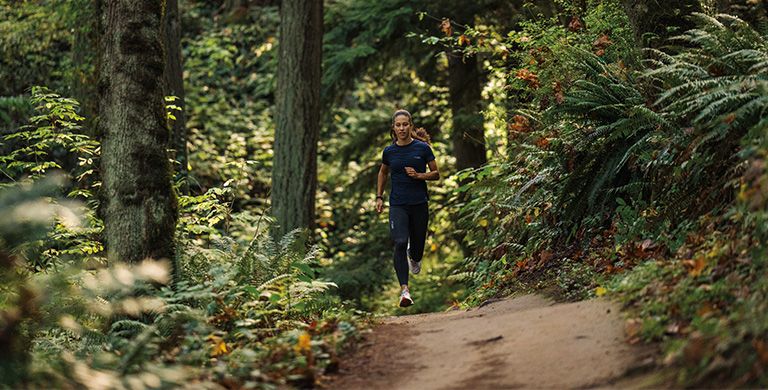TRAIL RUNNING
Race Ready: Own Your Run with a Well-Planned Race Calendar
Running races isn’t just about competition; it’s about finding your focus. Whether you’re chasing a new personal record or crossing the finish line for fun, having a goal gives your runs purpose and keeps you motivated.
BY: NANCY BOUCHARD
Races are for everyone—elite athletes, weekend warriors, and anyone looking for a reason to lace up. They’re a great way to level up your running, whether you’re exploring new distances, staying active, or connecting with the running community. Plus, races are the perfect excuse for travel, giving you an excuse to explore exciting locations while pursuing your goals.

From Start to Finish: The Case for a Race Calendar
Without a goal, running can feel aimless, like driving with no destination. Races provide that clear focus—a finish line to aim for. From the excitement of the crowd to the camaraderie of fellow runners, races make running more rewarding.
The benefits go beyond the physical: you’ll stay inspired, build confidence, and experience the joy of crossing that finish line. Whether it’s a local 5K or a destination marathon, every race is an opportunity to grow as a runner
The benefits go beyond the physical: you’ll stay inspired, build confidence, and experience the joy of crossing that finish line. Whether it’s a local 5K or a destination marathon, every race is an opportunity to grow as a runner
Expert Advice: Adam Chase on Building Your Best Race Plan
We spoke with Adam Chase, co-author of The Ultimate Guide to Trail Running and President of the American Trail Running Association, for his expert insights.
Q: What are the advantages of increasing mileage and frequency?
Adam Chase: Most of us start running a mile or two a couple of times a week for exercise. What are the advantages to increasing mileage/frequency?
The “more is better” approach to running, isn’t necessarily the best, depending on one’s ultimate objective. Running for more time, distance and more often should only be the goal if you want to run longer, farther and hopefully faster. If your goal is simply to maintain a level of fitness, you needn’t rack up the miles or number of runs.
Frequent long runs, mixed in with shorter speed efforts, will help speed up your running by causing gradual physiological changes that adapt your body to become more efficient. But that accommodation may be accompanied by loss of muscle mass and other changes, some of which are less welcome.
One benefit of achieving running efficiency from being able to run long and to do so on a daily or almost daily basis, is that runs evolve from being a physical workout to a mental break in one’s day; an escape, break or recess, if you will. Mixing in other types of exercise—cross-training--keeps things from becoming a routine.
The “more is better” approach to running, isn’t necessarily the best, depending on one’s ultimate objective. Running for more time, distance and more often should only be the goal if you want to run longer, farther and hopefully faster. If your goal is simply to maintain a level of fitness, you needn’t rack up the miles or number of runs.
Frequent long runs, mixed in with shorter speed efforts, will help speed up your running by causing gradual physiological changes that adapt your body to become more efficient. But that accommodation may be accompanied by loss of muscle mass and other changes, some of which are less welcome.
One benefit of achieving running efficiency from being able to run long and to do so on a daily or almost daily basis, is that runs evolve from being a physical workout to a mental break in one’s day; an escape, break or recess, if you will. Mixing in other types of exercise—cross-training--keeps things from becoming a routine.
Q: How does a person set realistic running goals? How do you stay motivated and avoid burnout?
Adam Chase: When you can answer the question, “What place does running hold for me in my life?” you can begin to put solid plans together to plot out the steps necessary to get there. If you just want to remain fit and enjoy occasional runs, then you know to keep it fun. Alternatively, if your goal is to race a fast 10K, marathon, or even ultra-marathon, those events require more dedication and months of rigorous training.
Goal setting and keeping one’s running objectives real requires a keen sense of one’s abilities. Biting off more than one can chew often leads to disappointment or injury so it may help to plot out multiple, small steps in trying to get to the greater goal.
Goal setting and keeping one’s running objectives real requires a keen sense of one’s abilities. Biting off more than one can chew often leads to disappointment or injury so it may help to plot out multiple, small steps in trying to get to the greater goal.
Q: Signing up for a race, or multiple races, seems like a good way to stay motivated. How do I decide on a distance to train for? Road or trail?
Adam Chase: Gradual progressions in race distance and difficulty are the way to go. You can always race a shorter race harder and faster and then, once you feel satisfied with that, go longer. Switching around is fun for a lot of runners, mixing in 5 or 10Ks with half and full marathons and an occasional ultra. Longer races take a greater toll on one’s body and require longer recoveries so be sure to schedule plenty of time after a marathon or ultra to allow yourself to recuperate. But, yes, racing does give your training a sharpened focus. Trails are easier on the body so, if accessible, that could help to decrease the likelihood of overuse injury.
Q: If I am just starting out running, how long will it take me to run a half marathon? Can I train on my own, or do I need a coach? Is a marathon or ultra-distance within anyone's reach if they train right?
Adam Chase: Being able to move up in race distance, say from a 5K to 10K to half marathon, depends on many factors, such as one’s prior running history, being injury prone, schedule flexibility, diet, other commitments, etc. Any one of those factors could sabotage one’s plans so being agile in adjusting one’s goals is crucial.
A beginner could successfully train for a half, but being able to accomplish that goal within a year requires a lot of dedication and your body should be one to adapt well to running. Many do not and recognizing that early may save your joints.
Joining a running group or running with experienced runners able to critique running form is a good idea. A running coach or on-line program offering a training schedule helps to plot the course.
Running a marathon or ultra is achievable, if one approaches that goal in a measured fashion. There is a marked difference between “completing” a marathon or ultra and “racing” one. To race that distance likely requires more than a year’s training for most beginners.
A beginner could successfully train for a half, but being able to accomplish that goal within a year requires a lot of dedication and your body should be one to adapt well to running. Many do not and recognizing that early may save your joints.
Joining a running group or running with experienced runners able to critique running form is a good idea. A running coach or on-line program offering a training schedule helps to plot the course.
Running a marathon or ultra is achievable, if one approaches that goal in a measured fashion. There is a marked difference between “completing” a marathon or ultra and “racing” one. To race that distance likely requires more than a year’s training for most beginners.

Q: Do I need special equipment to be a runner? Is it important to time and track my runs?
Adam Chase: One of the best aspects of running is that the sport requires so little as far as gear: a good pair of shoes. Although you can knock yourself out with a watch that tracks almost every aspect of your running, e.g., step cadence, heart rate, distance, speed, and vertical gain, there is also a school of thought that encourages running by feel. As an aside, several years ago I became obsessed with my annual vertical accumulation and decided that wasn’t healthy and have run without a watch ever since.
Q: How many races can I sign up for during a year? Should I focus on a single distance, or keep upping the distance? Does everyone have an ideal distance that suits their body type and running style?
Adam Chase: My general advice for racing, unless the runner is at the professional level, is to keep it fun. As such, I would recommend spicing up one’s race schedule with a variety of distances and types of runs. Mix in training runs that you take less seriously.
Q: How do I set realistic running goals?
Adam Chase: Keeping it fun should help. Being conservative about expectations never hurts. If you find yourself winning local races, that may be the time to try bigger events. I always tell people to race the shortest distance at which they can win and only go longer when necessary. Speed almost never comes back so use it while you have it.
Q: Any tips on figuring out a training and race calendar?
Adam Chase: It is important to have goal races mixed in with what are more of “training races” that are sort of practice efforts or tune-ups, involving less stress and pressure. They are often local and less expensive. Something like the local turkey trot 10K before traveling to a warm weather half marathon in early winter.
Q: How do I recognize potential injuries and avoid them?
Adam Chase: The ability to detect a potential problem before it flares up into a show-stopping injury is often only gained from bad experiences. Being in touch with one’s body is, often a skill gained from suffering being sidelined. Knowing when to back off in one’s training effort is a challenging lesson to learn. Heeding early signs takes a keen sense of one’s body that may be more attuned with less pain killers or anti-inflammatory meds.
Q: If I'm running a lot, do I need to change my diet? What does nutrition look like if you are racing?
Adam Chase: Diets are like religions. Other than the obvious advice of hydrating regularly with sufficient electrolytes and getting enough caloric intake with protein to help the body repair itself, I won’t dare preach anything. Each person is unique and what may work for one person doesn’t do the trick for another. And even for the same person at different times of their life.

How to Build Your Race Calendar
1. Pick Your Distance
Choose distances that match your fitness and goals. Beginners often start with 5Ks or 10Ks before progressing to half marathons or marathons. Ultra-marathons, like 50K or 100K races, require advanced planning and specialized skills.
2. Pick Your Races
Select races that excite you, whether they’re local or destination events. Consider factors like weather, course difficulty, and logistics. From fun runs with costumes to scenic marathons, there’s something for everyone.
3. Set Realistic Goals
Define clear targets, whether it’s achieving a PR, finishing your first 5K, or tackling a marathon. Keep your goals achievable and focus on the journey, not just the finish line.
4. Train Smart
Match your training to your race goals. Shorter races emphasize speed, while longer ones require endurance and strength. Incorporate rest days, cross-training, and “tune-up” races to stay sharp.
5. Prioritize Recovery
Rest is essential after races. Schedule downtime between events, especially after longer races. Active recovery, like light stretching or walking, can help your body bounce back faster.
6. Turning Racing into a Lifestyle
Racing isn’t just a hobby—it’s a way of life. The adrenaline, the community, and the sense of accomplishment create memories that last far beyond race day. Many events, from local fun runs to iconic marathons, come with post-race celebrations, complete with music, food, and massages for tired legs. Enjoy the après race scene, make new friends, and start planning for your next racing adventure.
Whether you’re tackling a weekend 5K or a bucket-list marathon, prepare for your next challenge with Columbia Sportswear running gear.



